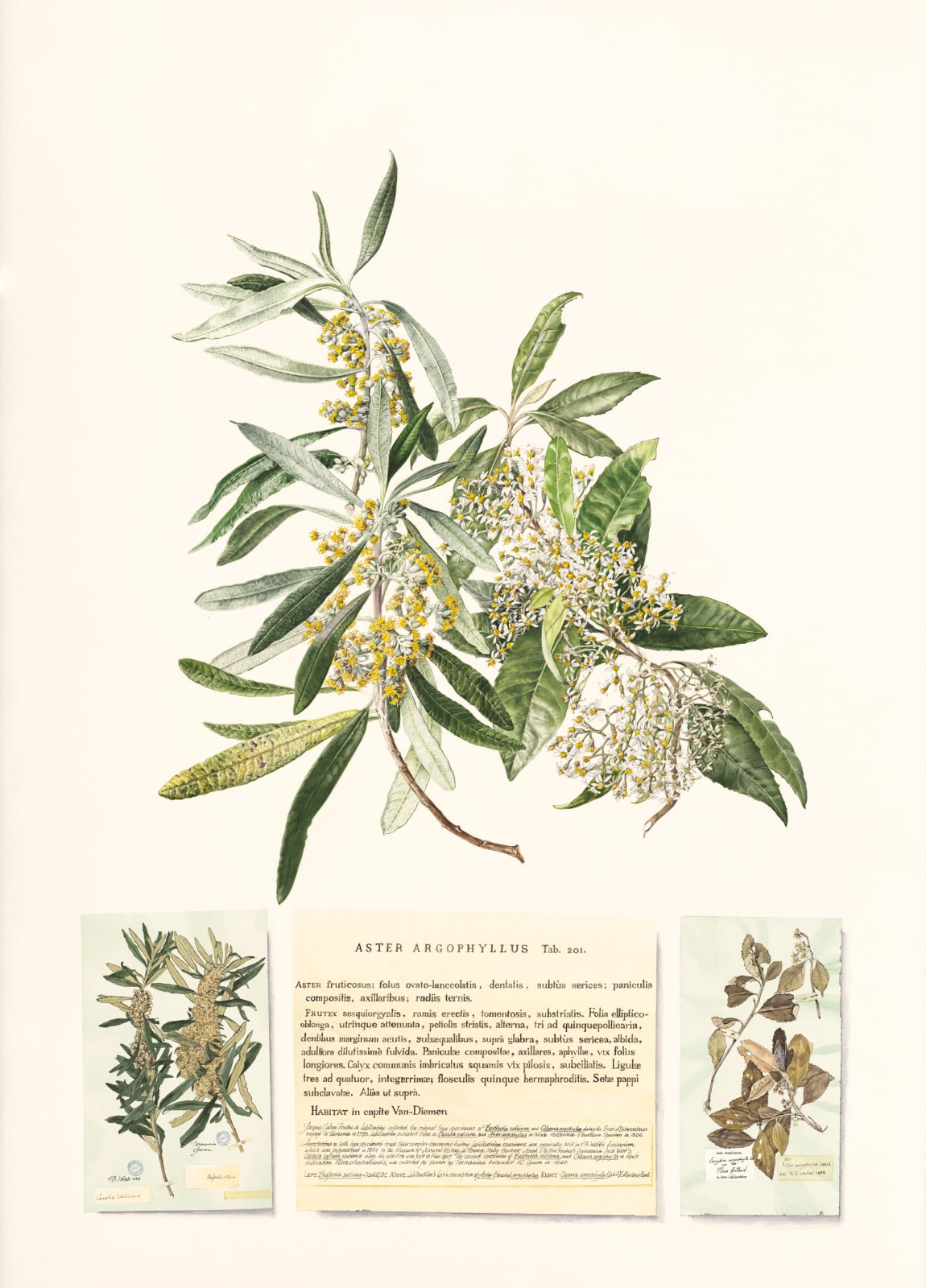Lynne Uptin
Labillardiere’s finds, 2023
watercolour on Fabriano watercolour paper 640gsm, framed
102 x 73 cm (paper size) 115 x 86 cm (frame size)
BG9609
Sold
Three plants in this painting were first described by French botanist Jacques Labillardière who visited lutruwita/Tasmania in 1792/93 with the d'Entrecasteaux expedition. Between 1804 and 1806, he published Novae Hollandiae...
Three plants in this painting were first described by French botanist Jacques Labillardière who visited lutruwita/Tasmania in 1792/93 with the d'Entrecasteaux expedition. Between 1804 and 1806, he published Novae Hollandiae Plantarum Specimen in two volumes, the first general description of the flora of Australia. Labillardière had named and described more Australian flora than any other botanist of the day. The work describes the botanical collections made by Labillardière and his companion on the d'Entrecasteaux expedition, Claude Riche. Extensive collections were made at Recherche Bay and the D’Entrecasteaux Channel during his two visits to Tasmania. The work was the most comprehensive description of Australian plants until Robert Brown published his Prodromus Florae Novae Hollandiae et Insulae Van Diemen in 1810.
On the return voyage, Labillardière's collections were seized by the English as spoils of war. He despaired at the loss of three years' painstaking work. The collections were returned to him in France in 1796 after the intervention of Joseph Banks, an influential ally with whom he had established an enduring friendship earlier in Britain.
Bedfordia salicina (Labill) Tasmanian blanketleaf is endemic to Tasmania and is found in dry to wet sclerophyll forests, commonly on highly fertile Jurassic Dolerite soils, from sea level to 1,000 m elevation. Formerly described as Cacalia salicina by Labillardière, the herbarium specimen page traces its collecting history from Ronald Gunn through to the Hooker Herbarium now held at Kew Gardens.
Olearia argophylla (Labill.) F. Muell. ex Benth. Musk daisy-bush. The herbarium specimen is the isotype and the accompanying description by Jacques Labillardière in 1806 who gave it the name Aster argophyllus. [Tasmania]: It was collected in lutruwita/Tasmania "In capite Van-Diemen". The isotype is the Labillardière Herbarium held in the Museum of Natural History, University of Florence, Italy. In 1867, George Bentham changed the name to Olearia argophylla in Flora Australiensis.
Pomaderris apetala Labill. Dogwood was first described in the publication Novae Hollandiae Plantarum Specimen by Jacques - Julien Houtou de Labillardière in 1805.
On the return voyage, Labillardière's collections were seized by the English as spoils of war. He despaired at the loss of three years' painstaking work. The collections were returned to him in France in 1796 after the intervention of Joseph Banks, an influential ally with whom he had established an enduring friendship earlier in Britain.
Bedfordia salicina (Labill) Tasmanian blanketleaf is endemic to Tasmania and is found in dry to wet sclerophyll forests, commonly on highly fertile Jurassic Dolerite soils, from sea level to 1,000 m elevation. Formerly described as Cacalia salicina by Labillardière, the herbarium specimen page traces its collecting history from Ronald Gunn through to the Hooker Herbarium now held at Kew Gardens.
Olearia argophylla (Labill.) F. Muell. ex Benth. Musk daisy-bush. The herbarium specimen is the isotype and the accompanying description by Jacques Labillardière in 1806 who gave it the name Aster argophyllus. [Tasmania]: It was collected in lutruwita/Tasmania "In capite Van-Diemen". The isotype is the Labillardière Herbarium held in the Museum of Natural History, University of Florence, Italy. In 1867, George Bentham changed the name to Olearia argophylla in Flora Australiensis.
Pomaderris apetala Labill. Dogwood was first described in the publication Novae Hollandiae Plantarum Specimen by Jacques - Julien Houtou de Labillardière in 1805.
6
of
6
